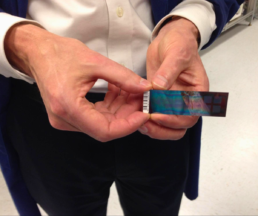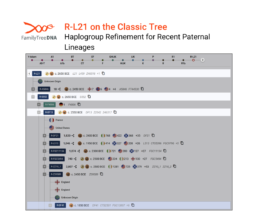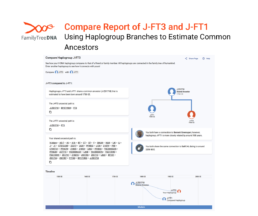By: Janine Cloud
Noticed a Y-DNA haplogroup in your Family Finder™ results? This guide explains how some Y-DNA SNPs included on the autosomal test chip allow us to assign a paternal haplogroup—and what it means for your ancestry research.
If you’ve been wondering about Y-DNA haplogroups from Family Finder and autosomal transfers, you’re not alone! We’ve seen discussions on social media and received emails about this topic, so let’s clear things up with a quick refresher.
How Family Finder Detects Y-DNA Haplogroups Using SNPs
Family Finder and other autosomal DNA tests use advanced chip-based microarray technology to process DNA. This method analyzes hundreds of thousands of genetic markers called Single Nucleotide Polymorphisms (SNPs) on a small glass strip, enabling us to deliver detailed results, including Y-DNA haplogroup information for male testers.
Over the years, our testing technology has evolved:
- 2010–2015: Early Family Finder chips contained few Y-DNA SNPs. Males tested during this time did not receive Y-DNA haplogroup.
- October 2015: FamilyTreeDNA designed a custom chip that introduced select Y-SNPs.
- April 2019: The Global Screening Array (GSA) chip allowed even more refined SNP-based haplogroup resolution.
Why Family Finder Includes Y-DNA Haplogroups in Results
Haplogroups are a big part of Y-DNA testing because they show where your paternal line fits into the broader tree of human ancestry. Think of them as branches on the Y-DNA haplotree—each one representing a shared common ancestor at some point in history. Understanding your haplogroup can help place your paternal lineage in the context of ancient migrations, historical populations, and even more recent family connections.
Understanding your Y-DNA haplogroup provides insight into:
- Migration Patterns and Deep Ancestry (e.g., Haplogroup R-M269 suggests European paternal lineage)
- Historical Population Connections (e.g., Celts, Vikings)
- Paternal Line Clustering for Surname and Haplogroup Projects
Y-DNA Haplogroups and Deep Ancestry Migration Patterns
Haplogroups tell the story of deep ancestry, often stretching back thousands of years. Each haplogroup is defined by unique SNPs—tiny mutations that mark major branching points in the paternal lineage over time. These markers don’t tell you who your ancestor was—but where their lineage came from.
Example: If you’re part of Y-DNA haplogroup R-M269, your distant paternal ancestors were likely in Europe thousands of years ago.
Some haplogroups have been associated with historical populations like the Celts, Vikings, or early Native American groups, but it’s important to remember that a haplogroup alone doesn’t confirm personal descent from any particular group. It simply shows a genetic connection to men who shared that lineage.
Haplogroup Refinement for Recent Paternal Lineages
As mutations continue to accumulate over generations, haplogroups branch into more refined subgroups (called subclades). These subclades can help track more recent connections between families and surname lineages.
Example: If you and another tester both fall under R-L21, but he is R-DF13 and you are R-DF41, then your shared ancestor lived farther back in time than the ancestor who first had the R-DF41 SNP. The closer the SNP match, the more recent the common ancestor.
This kind of haplogroup refinement is especially useful for genealogists trying to narrow down timeframes and geographic locations for their direct paternal line.
Using Y-DNA Haplogroups to Join Projects and Find Matches
Genetic males who have taken a Family Finder test or uploaded their autosomal DNA will be placed into a haplogroup based on your SNPs. From there, you can:
- Search surname or haplogroup Group Projects to connect with others who share your lineage.
- Use haplogroups to refine your match list—the more closely your haplogroups align with someone in your Family Finder match list, the more recent your common paternal ancestor is likely to be.
Using Haplogroup Branches to Estimate Common Ancestors
Haplogroups also help estimate when two people shared a common ancestor. Researchers can approximate when those mutations occurred, especially with higher-resolution tests like Big Y-700.
Example: If your haplogroup branch is estimated to have formed around 1600 AD, that means your most recent common ancestor with others in that branch likely lived around that time.
How Y-DNA Haplogroups Support Genealogy and Family History Research
If your traditional family tree only traces back to the 1700s, but your Y-DNA haplogroup connects you to a surname cluster with proven records going back to the 1400s, that’s a major clue. It might point you toward a specific region, surname variation, or historical record set you hadn’t considered before.
In short, haplogroups provide the framework for your paternal ancestry. They offer insight into both the ancient origins of your lineage and its more recent branching points. But for truly useful genealogical discoveries, you need to combine haplogroup data with actual Y-DNA matches, STR testing, and traditional records research.
Haplogroups provided through Family Finder or supported transfer tests are typically at a mid-range SNP resolution, often reflecting lineages from the Metal Ages (approximately 8,000–3,000 BCE). If you’ve already taken a Y-DNA STR test—like Y-37 or Y-111—the confirmed haplogroup based on SNPs from Family Finder will replace the earlier STR-based prediction.
To estimate a more recent Time to Most Recent Common Ancestor (TMRCA), you’ll need to add-on the Big Y-700 test. This advanced test sequences a much larger portion of the Y chromosome, detecting many more SNPs and enabling a more precise, refined haplogroup assignment.
Which Y-DNA Haplogroups You’ll See in Family Finder and Transfers
When you take a Family Finder test or transfer certain data, here’s what you might encounter:
Y-DNA Haplogroup Badge:
- “Confirmed”: Appears for male testers using Family Finder or unlocked MyHeritage transfers. Visible to matches and within group projects.
- “Third Party”: Shown for other transfers. These are only visible to the tester and do not appear in match lists or project displays.
Other Y-DNA Features:
- Y-STR Results Section: Access the Haplotree & SNPs page and view Discover™ reports for insight into haplogroup placement and SNP history.
- Y-SNP Raw Data Download: Found under Family Finder Results → Download Raw Data. Great for advanced users who want to analyze SNPs offline or import into external tools.
Why Some Transfer Haplogroups Don’t Appear in Matches or Stats
Family Finder tests and lab-verified MyHeritage transfers contribute to the Y-DNA Haplotree and Discover tools. That means your Y-DNA haplogroup is visible to your matches and Group Project Administrators.
For quality control, Y-DNA haplogroups from third-party transfers are not included in Family Finder match lists or statistical reporting. Since we cannot verify the accuracy of third-party lab data, there is a risk of degraded or altered results affecting haplogroup assignment.
However, MyHeritage transfers that we process in our lab are treated the same as Family Finder tests. Their data remains intact during the transfer process, allowing for accurate haplogroup assignment and inclusion in match and project statistics.
By focusing on accuracy and reliability, FamilyTreeDNA ensures that your Y-DNA haplogroup data supports meaningful genealogical discoveries—without the confusion of unverified results.
Next Steps for Exploring Your Paternal Haplogroup
Want to pinpoint a more recent paternal ancestor?
Add-on the Big Y-700 test to get the most refined haplogroup assignment and discover detailed connections on your Y-DNA line.
For additional guidance, visit our Help Center or explore our Y-DNA blog library for step-by-step resources and research tips.

About the Author
Janine Cloud
Group Projects Manager
Janine Cloud became interested in genealogy when a grade school assignment to complete a pedigree chart prompted her to begin questioning family members about her ancestors. She began working at FamilyTreeDNA in 2011, where she created the Group Projects team to assist Group Project Administrators and Group Project members.
Janine is also the event coordinator, handling arrangements for all the events and conferences that FamilyTreeDNA supports. She is a fifth-generation Texan, and a registered member of the Cherokee Nation.




